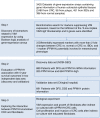Low tumour PPM1H indicates poor prognosis in colorectal cancer via activation of cancer-associated fibroblasts
- PMID: 30988394
- PMCID: PMC6734651
- DOI: 10.1038/s41416-019-0450-5
Low tumour PPM1H indicates poor prognosis in colorectal cancer via activation of cancer-associated fibroblasts
Abstract
Background: Vimentin (VIM) is considered a prognostic marker in colorectal cancer (CRC). Our aim is to identify genes that fulfil a "X-low implies VIM-high" Boolean relationship and to evaluate their prognostic value and potential mechanism.
Methods: Potential biomarkers related to VIM expression were searched using a bioinformatics approach across gene-expression arrays. Based on subgroup analysis of 2 CRC cohorts, the selected gene was tested for its association with patient's survival outcomes. The regulatory link between the selected gene and VIM was further examined with in vitro models.
Results: PPM1H was identified as the top candidate in our search. Patients with PPM1H-low tumours have a lower 5-year disease-free survival rate than patients with PPM1H-high tumours in 2 independent cohorts. In multivariate Cox analysis, patients with PPM1H-low tumours were independently associated with relapse in both the discovery cohort (hazard ratio [HR], 1.362; 95% confidence interval [CI], 1.015-1.826; P = 0.039) and the validation cohort (HR for DFS, 4.052; 95% CI, 2.634-6.234; P < 0.001). PPM1H knockdown in CRC cells and growth in the corresponding conditional medium increased VIM expression and colon fibroblast proliferation, indicating a transformation of cancer-association fibroblasts (CAFs). Conversely, educated CAFs also facilitated the growth of CRC cells with low PPM1H expression.
Conclusions: Lack of tumour PPM1H expression identifies a patient subgroup with a high relapse risk, and CRC cells with low expression of PPM1H activate CAFs and inversely get promoted by CAFs.
Conflict of interest statement
The authors declare no competing interests.
Figures




References
-
- Bray Freddie, Ferlay Jacques, Soerjomataram Isabelle, Siegel Rebecca L., Torre Lindsey A., Jemal Ahmedin. Global cancer statistics 2018: GLOBOCAN estimates of incidence and mortality worldwide for 36 cancers in 185 countries. CA: A Cancer Journal for Clinicians. 2018;68(6):394–424. - PubMed
Publication types
MeSH terms
Substances
LinkOut - more resources
Full Text Sources
Medical
Miscellaneous

